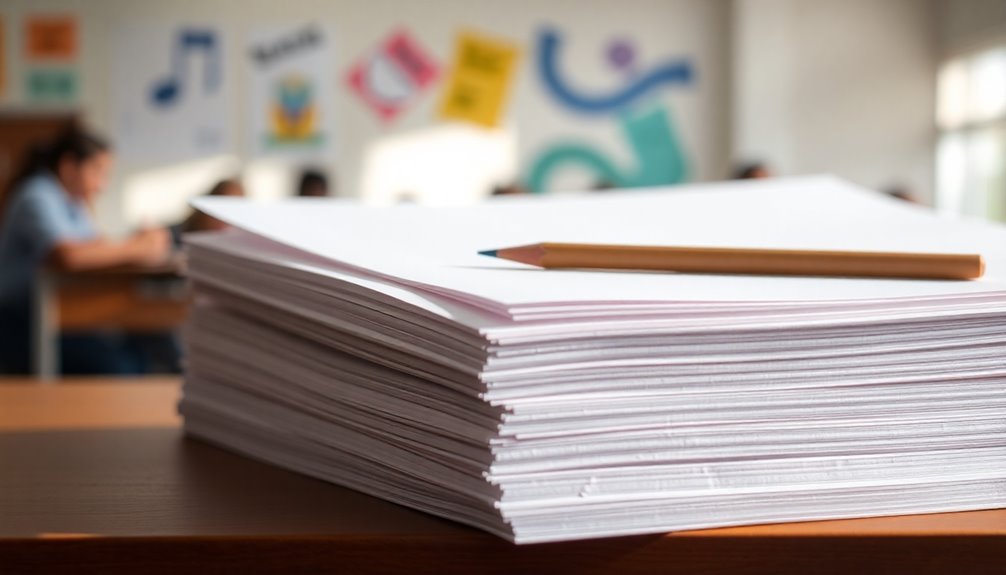Copy paper plays a surprising role in education and the environment that schools might not mention. Most people think all copy paper is the same, but there are various types, like recycled and specialty options, each impacting print quality and your ecological footprint. Schools generate massive paper waste, and opting for recycled paper can help reduce the environmental strain. Moreover, transitioning to digital resources could enhance learning and engagement while cutting costs and waste. Understanding these dynamics can reshape how you view paper's role in education, so stick around to uncover more about the industry's hidden truths.
Key Takeaways
- Schools heavily rely on printed materials, with each student using about 10,000 sheets of paper annually, leading to significant waste.
- Paper production contributes to deforestation, with 1.3 billion trees cut down yearly, impacting biodiversity and ecosystems.
- Recycling paper can reduce energy consumption by up to 60%, highlighting the importance of sustainable practices in schools.
- Transitioning to digital resources can enhance student engagement and reduce the environmental footprint associated with traditional paper use.
- Schools spend around $1,000 annually on paper supplies, creating financial strain and limiting funds for other educational resources.
Misconceptions About Paper Types
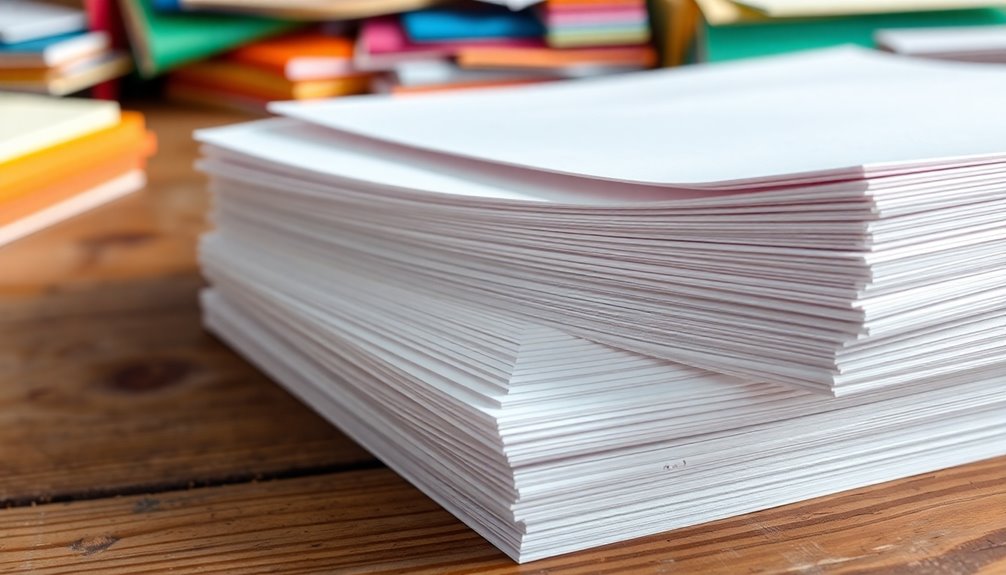
Many people hold misconceptions about the different types of copy paper available. For instance, you might think that all copy paper is the same, but that couldn't be further from the truth. Standard copy paper is typically 20 lb and 92 brightness, perfect for everyday printing tasks. If you're looking for something more professional, consider using a heavier option, like 24 lb paper.
Then there's recycled copy paper, which comes from post-consumer waste. While it's a great choice for those who want to reduce their environmental impact, it may have slightly lower brightness and smoothness compared to standard paper. Don't overlook specialty papers, either. These include glossy or textured options designed specifically for color printing, brochures, or presentations, adding a unique visual appeal.
Choosing the right type of paper can significantly affect not just the quality of your prints, but also your printer's performance. Different papers might require specific settings or even different types of printers to achieve the best results. So, understanding the distinctions between standard, recycled, and specialty papers can make a big difference in your printing experience.
Types of Copy Paper Explained
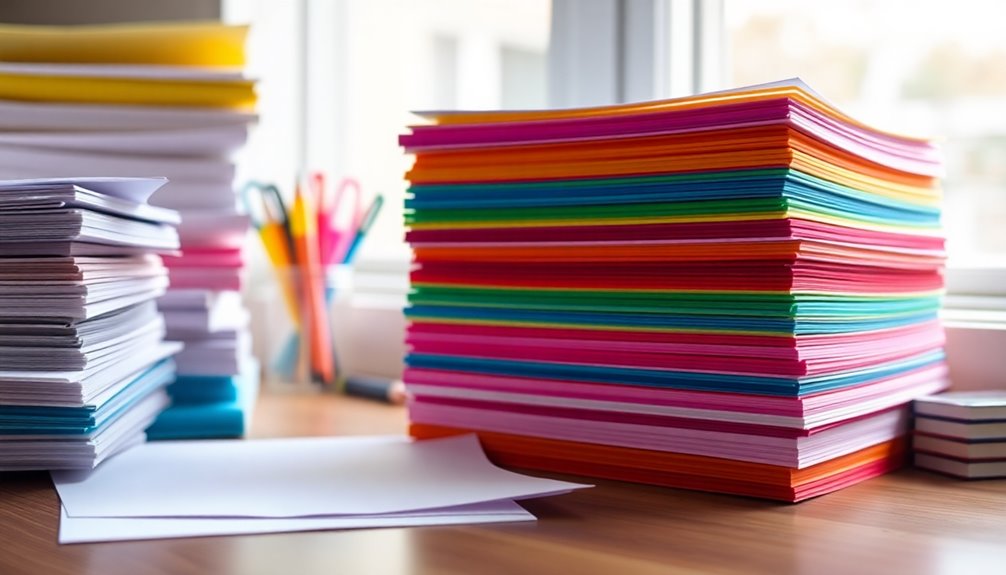
When it comes to choosing copy paper, understanding the different types available can make all the difference. You'll find several types, including multipurpose, inkjet, laser, and specialty papers, each tailored for specific printing needs and equipment compatibility.
The standard weight for copy paper is 20 pounds (lb), which strikes a balance between thickness and affordability. If you need something sturdier, consider 24 lb options, which offer increased durability for professional documents.
Brightness is another critical factor to think about. Measured on a scale from 1 to 100, higher brightness levels indicate whiter paper, leading to sharper text and more vibrant colors in your prints.
If you're eco-conscious, recycled copy paper is a worthwhile choice. Made from post-consumer waste, it's not only sustainable but often available in various weights and brightness levels, ensuring you don't have to compromise on quality.
Most copy paper is sold in reams of 500 sheets, and you can usually find information on the packaging regarding weight, brightness, and recommended uses. This way, you can easily select the right type for your printing projects.
Use Recycled Paper for Sustainability
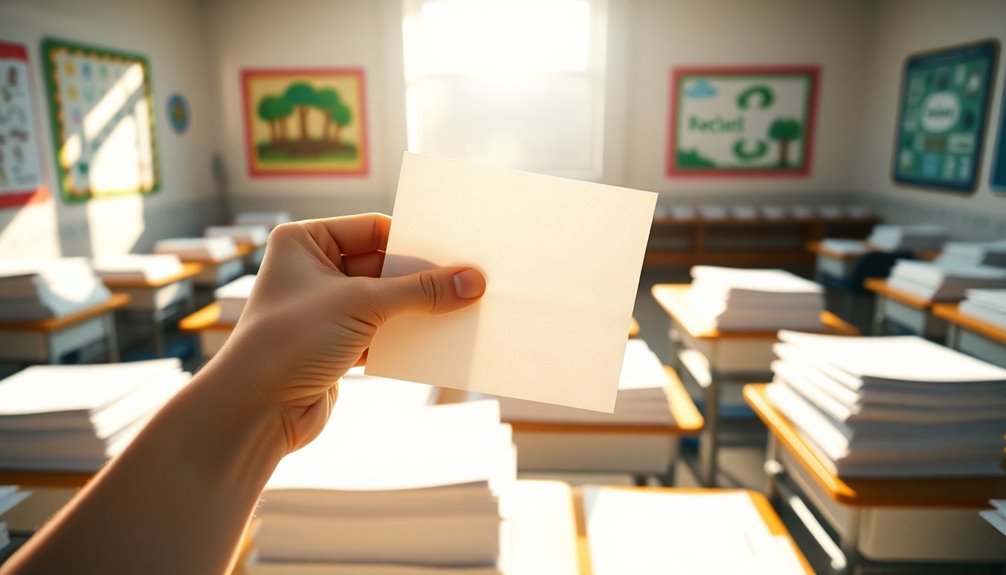
Opting for recycled paper not only benefits your printing needs but also plays a crucial role in promoting sustainability. By choosing recycled paper, you help reduce the demand for virgin pulp, which saves about 24,000 trees for every ton produced. This choice leads to significant waste reduction, as recycled paper can divert millions of tons from landfills. In fact, around 70% of paper consumed in the U.S. was recycled in 2020, showcasing the impact schools can have in this effort. Additionally, using recycled paper conserves energy, requiring 40% less energy than producing paper from raw materials. This means lower greenhouse gas emissions and a smaller carbon footprint for your school. You'll also conserve approximately 7,000 gallons of water for each ton of recycled paper manufactured, making this an eco-friendly practice worth adopting. Furthermore, sustainable forestry practices ensure that wood used in producing paper supports renewable resources and reduces the reliance on fossil fuels. By making this switch, schools can also contribute to job creation in the recycling and manufacturing sectors.
Moreover, the use of natural materials in decor, such as bamboo and wood, emphasizes a commitment to sustainability in various aspects of school life. When schools switch to recycled paper, they demonstrate a commitment to sustainability, encouraging students' environmental awareness. This influence fosters a culture of eco-friendly practices within the community, empowering everyone to contribute positively to the environment. So, make the switch; it's a simple yet effective step toward a greener future.
Environmental Impact of Paper Use
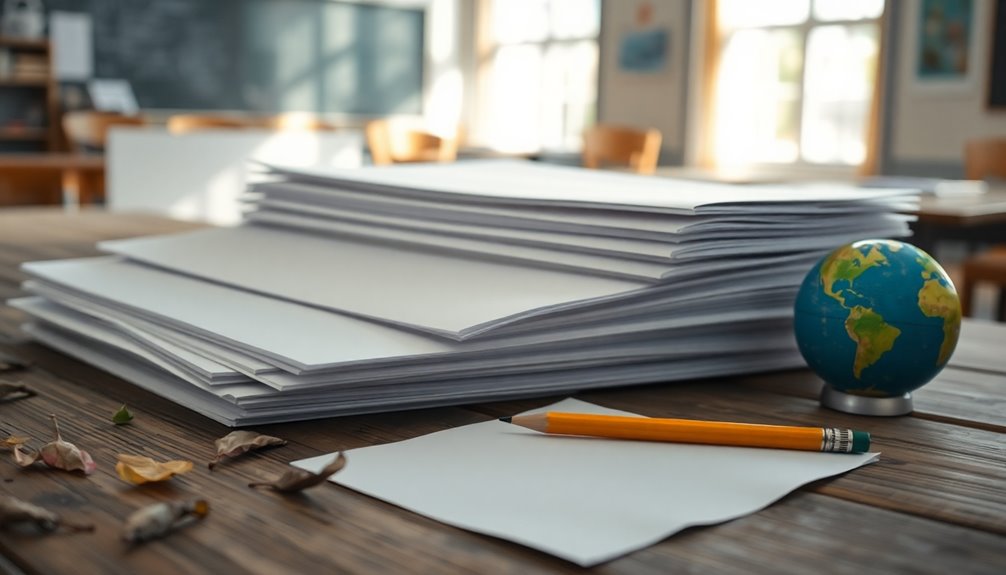
The environmental impact of paper use is staggering, with approximately 1.3 billion trees cut down each year solely for paper production. This deforestation leads to habitat loss and a decline in biodiversity, as 40% of the world's industrial wood harvest is used for paper. Furthermore, paper production contributes to climate change; the loss of trees diminishes carbon sequestration, increasing greenhouse gas emissions.
Additionally, about 25% of global industrial water pollution stems from the chemical processes in pulp and paper mills, which release harmful contaminants into waterways. The average American uses around 700 pounds of paper annually, and the education sector generates about 2 billion pounds of paper waste each year. This highlights the urgent need for sustainable practices.
Recycling paper offers a powerful solution. By recycling, you can reduce energy consumption by up to 60% compared to producing new paper from virgin fibers. This not only lowers emissions but also lessens your ecological footprint. Embracing recycling and sustainable practices can significantly mitigate the negative effects of paper use, ensuring a healthier planet for future generations. Moreover, adopting sustainable practices such as using recycled paper can further lessen the demand for virgin materials and reduce environmental harm.
Paper Use in Schools
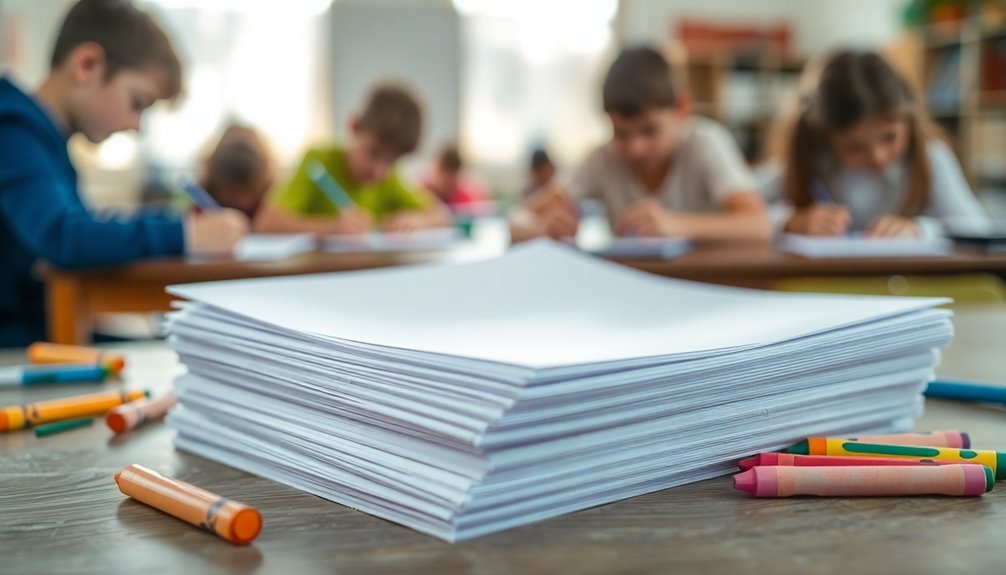
Every student in U.S. schools uses about 10,000 sheets of paper each year, creating a staggering amount of environmental waste. This high level of paper consumption not only contributes to deforestation but also places a significant financial burden on schools, which spend around $1,000 annually on paper supplies. With teachers managing paperwork for up to 50% of their time, direct instruction suffers, limiting the quality of education you receive.
Many classrooms still rely on outdated practices that favor printed materials over sustainable digital alternatives. This reliance means you might spend about 45 minutes a day on paper-based assignments, which can detract from opportunities for interactive learning experiences. Instead of engaging in discussions, group projects, or hands-on activities, you often find yourself buried in worksheets and handouts.
Transitioning to digital alternatives can help reduce both environmental waste and the financial strain on schools. By embracing technology, educators can streamline administrative tasks, allowing more time for direct instruction and interactive learning. It's time for schools to rethink their approach to paper use and consider the benefits of a more sustainable, engaging, and efficient educational environment.
Paper's Role in Education
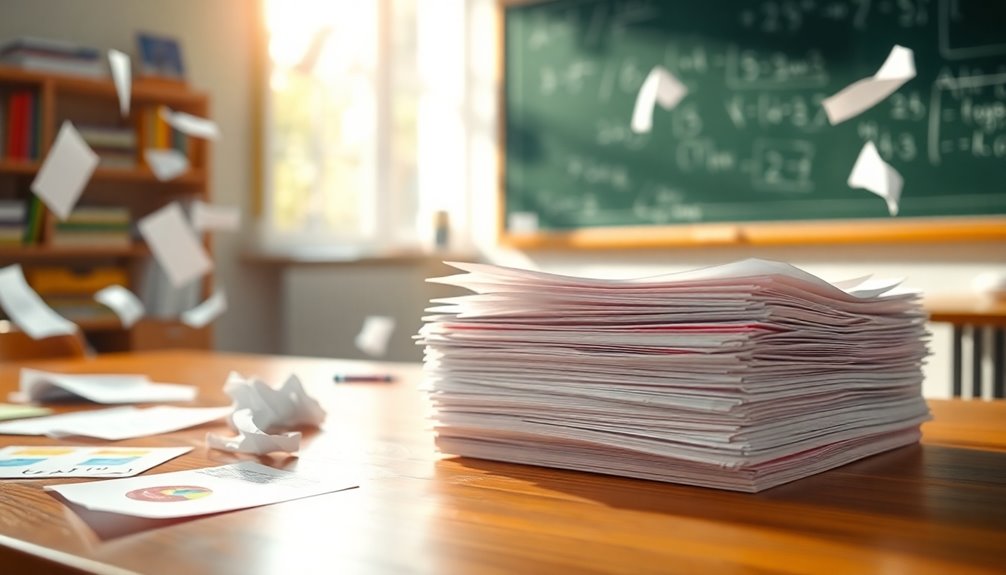
In many classrooms, paper serves as the backbone of educational materials, shaping how you learn and interact with content. You probably spend around 45 structured hours weekly in school, heavily relying on textbooks and worksheets. This traditional focus on paper-based assignments often promotes a culture of passive learning, leading to low-level seatwork instead of fostering critical thinking and engagement.
As you progress from elementary school to high school, the emphasis on paper can affect your chances of achieving good grades and securing college admissions. Science classes, like others, often rely on printed resources, limiting opportunities for innovative learning experiences. While technology continues to advance, many schools stick to outdated practices, opting for paper documentation over digital platforms.
This reliance on paper not only stifles interactive learning but also raises environmental concerns, as the education sector significantly contributes to deforestation and waste issues. Research suggests that transitioning to digital resources can enhance your engagement and retention, which is crucial for success in today's educational landscape. It's time for schools to rethink paper's role and embrace modern learning methods that better serve you as a student.
Frequently Asked Questions
What Is the Main Claim That John Taylor Gatto Makes?
John Taylor Gatto's main claim is that the traditional education system prioritizes obedience and conformity over critical thinking and creativity. He argues that compulsory schooling has failed to enhance literacy and instead stifles genuine learning. You'll notice that the focus on grades and standardized testing often detracts from real understanding, leaving students unprepared for life. Gatto advocates for a reform that encourages community involvement and practical skills, fostering individual growth and authentic education.
What Subjects Are No Longer Taught in School?
You might notice that many schools have cut important subjects like cursive writing, home economics, and the arts. These once-essential classes are now overshadowed by a focus on standardized testing and digital skills. Physical education often takes a back seat, too, replaced by less active options. Critical thinking and life skills courses, which are crucial for real-world success, rarely make the curriculum. This shift leaves students unprepared for everyday challenges they'll face.

